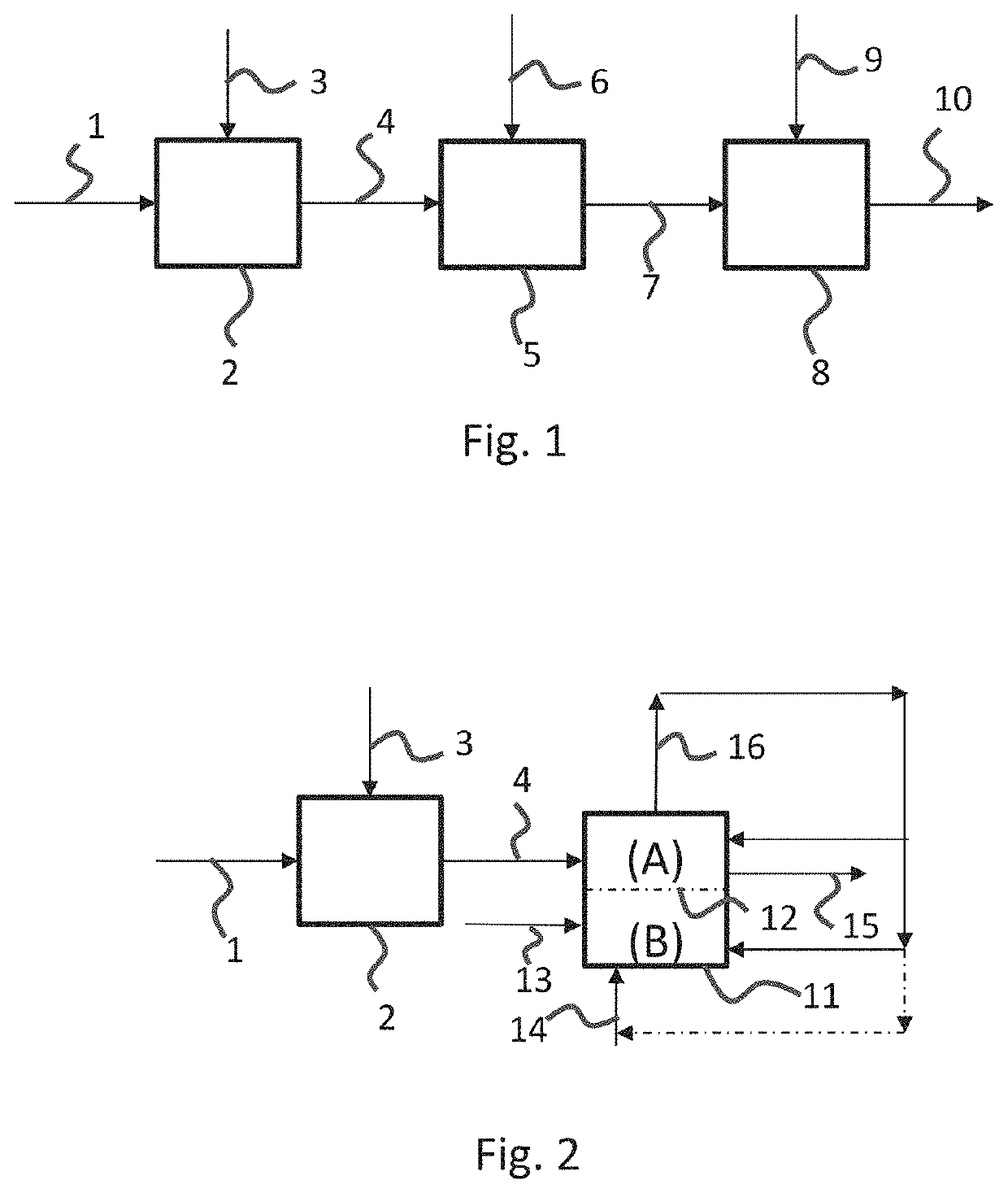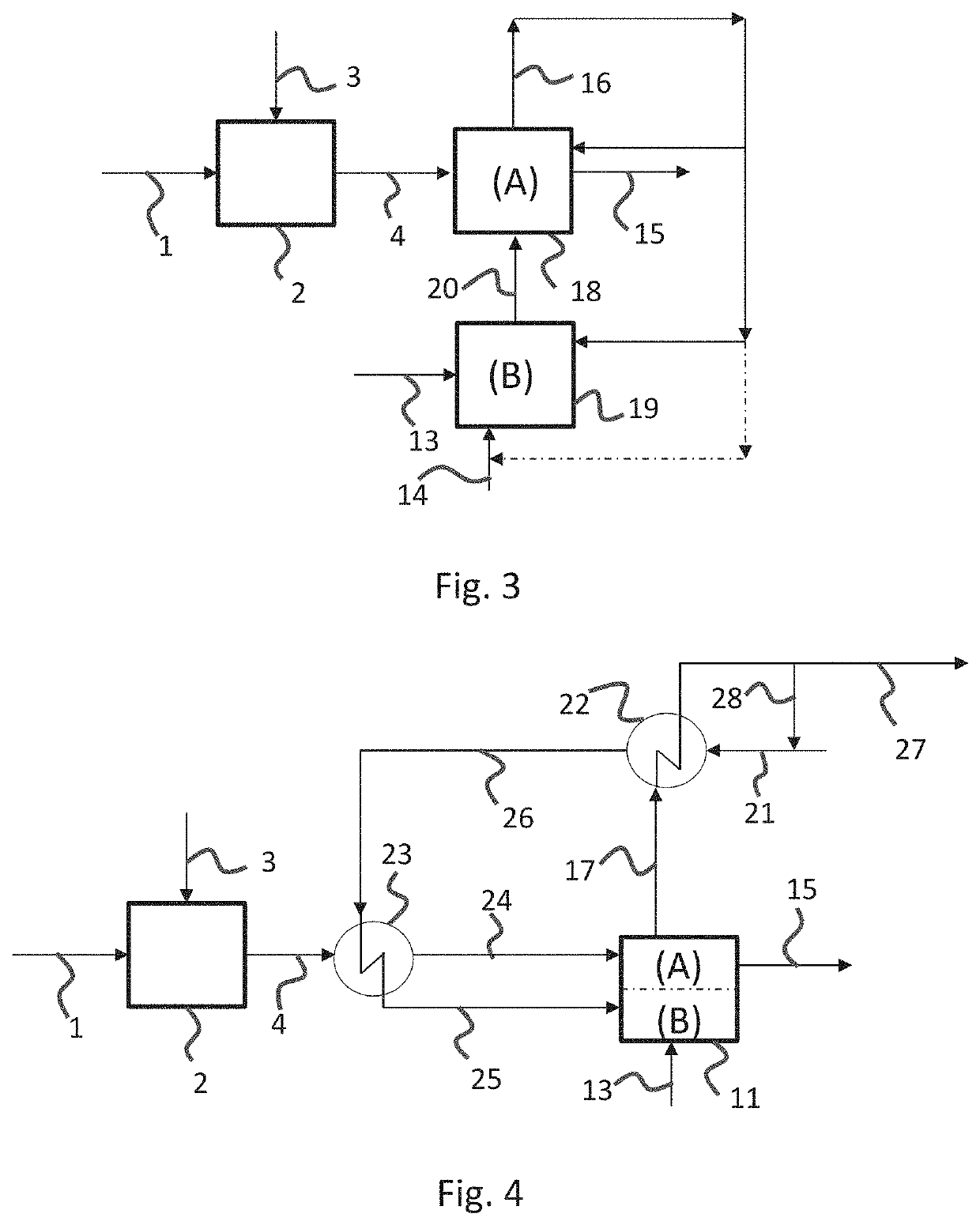Method for adding an organic compound to a porous solid in the gaseous phase
- Summary
- Abstract
- Description
- Claims
- Application Information
AI Technical Summary
Benefits of technology
Problems solved by technology
Method used
Image
Examples
example 1
on of CoMoP catalysts on alumina without organic compound C1 and C2 (Not in Accordance with the Invention)
[0095]To an alumina support having a BET surface area of 230 m2 / g, a pore volume measured by mercury porosimetry of 0.78 ml / g and a mean pore diameter of 11.5 nm defined as the volume median diameter by mercury porosimetry and which is in “extrudate” form, cobalt, molybdenum and phosphorus are added. The impregnation solution is prepared by dissolving, at 90° C., molybdenum oxide (21.1 g) and cobalt hydroxide (5.04 g) in 11.8 g of an 85 wt % aqueous solution of phosphoric acid. After dry impregnation, the extrudates are left to mature in a water-saturated atmosphere for 24 h at ambient temperature, then they are dried at 90° C. for 16 hours. The dried catalyst precursor thus obtained is denoted by C1. The calcination of the catalyst precursor C1 at 450° C. for 2 hours leads to the calcined catalyst C2. The final metal composition of the catalyst precursor C1 and of the catalyst ...
example 2
on of the CoMoP Catalyst on Alumina C3 (Not in Accordance with the Invention) by Co-Impregnation
[0096]To the alumina support described above in example 1 and which is in the “extrudate” form, cobalt, molybdenum and phosphorus are added. The impregnation solution is prepared by dissolving, at 90° C., molybdenum oxide (28.28 g) and cobalt hydroxide (6.57 g) in 15.85 g of an 85 wt % aqueous solution of phosphoric acid. After homogenization of the mixture, 38 g of citric acid were added before adjusting the volume of solution to the pore volume of the support by addition of water. The (citric acid) / Mo molar ratio is equal to 1 mol / mol and the (citric acid) / Co molar ratio is equal to 2.7 mol / mol. After dry impregnation, the extrudates are left to mature in a water-saturated atmosphere for 24 h at ambient temperature, then they are dried at 120° C. for 16 hours. The dried catalyst additivated with citric acid thus obtained is denoted by C3. The final metal composition of the catalyst C3 e...
example 3
on of the CoMoP Catalyst on Alumina C4 (Not in Accordance with the Invention) by Post-Impregnation
[0097]18 g of catalyst precursor C1 described above in example 1 and which is in the “extrudate” form are impregnated with an aqueous solution containing 3.2 g of 2-methoxyethyl 3-oxobutanoate and the volume of which is equal to the pore volume of the catalyst precursor.
[0098]The amounts used are such that the amount of 2-methoxyethyl 3-oxobutanoate is 0.8 mol per mole of molybdenum (corresponding to 2.2 mol per mole of cobalt). The extrudates are left to mature in a water-saturated atmosphere for 16 h at ambient temperature. The catalyst precursor C4 is then dried at 120° C. for 2 hours to give the catalyst C4. The final metal composition of the catalyst C4 relative to the weight of dry catalyst is: MoO3=19.5±0.2 wt %, CoO=3.8±0.1 wt % and P2O5=6.7±0.1 wt %.
PUM
| Property | Measurement | Unit |
|---|---|---|
| Temperature | aaaaa | aaaaa |
| Temperature | aaaaa | aaaaa |
| Pressure | aaaaa | aaaaa |
Abstract
Description
Claims
Application Information
 Login to view more
Login to view more - R&D Engineer
- R&D Manager
- IP Professional
- Industry Leading Data Capabilities
- Powerful AI technology
- Patent DNA Extraction
Browse by: Latest US Patents, China's latest patents, Technical Efficacy Thesaurus, Application Domain, Technology Topic.
© 2024 PatSnap. All rights reserved.Legal|Privacy policy|Modern Slavery Act Transparency Statement|Sitemap


